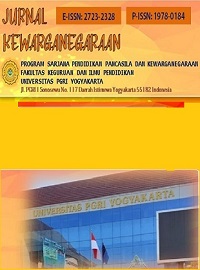Strategic Imperatives of National Defense System: The Ideal Indonesian Defence Posture Development Program in the Natuna Islands
DOI:
https://doi.org/10.31316/jk.v7i2.5733Abstract
Abstract
This article aims to explore the imperative of developing an ideal defence posture for the Natuna Islands, a strategically significant region for Indonesia's sovereignty and geopolitical interests. The proposed defence posture program involves a comprehensive strategy encompassing strengths, capabilities, and titles across both military and non-military dimensions. In terms of strength, a robust naval presence, technological advancements, and international collaborations are pivotal components. Modernizing naval assets, employing cutting-edge surveillance technologies, and engaging in joint exercises with global partners enhance Indonesia's maritime strength. Capability aspects extend beyond military prowess to encompass economic resilience, diplomatic finesse, and environmental stewardship. Investments in naval and air defence capabilities are complemented by economic development projects, sustainable resource management, and diplomatic initiatives, collectively fortifying the Natuna Islands' overall capabilities. The title aspects involve legal recognition and psychological alignment. Diplomatic efforts focus on securing international acknowledgment of Indonesia's sovereignty over the Natuna Islands, adhering to international laws and fostering positive relationships with neighbouring nations. Domestically, creating a sense of national identity and ownership contributes to the psychological title, aligning public sentiment with strategic imperatives. In the military domain, a holistic defence posture involves modernizing air and ground forces, establishing robust cyber defences, and ensuring the overall readiness of Indonesia's armed forces. Non-military aspects of the defence posture development program emphasize economic growth, diplomatic collaboration, and environmental sustainability. Leveraging the strategic location of the Natuna Islands for economic development, engaging in diplomatic dialogues with neighbouring nations, and implementing sustainable practices contribute to a comprehensive defence strategy.
Keywords: Defence Posture, Natuna Islands, Sovereignty, Geopolitical Interests, Strength Aspect, Capability Aspects, Title Aspect, Diplomatic Initiatives
References
REFERENCES
CNNIndonesia. (2020). Dibantu TNI BAKAMLA Tambah Kekuatan Hadapi China di Natuna. Https://Www.Cnnindonesia.Com.
Eksa, G. (2018). Panglima TNI Resmikan Satuan Terintegrasi Natuna. Mediaindonesia.Com.
https://thediplomat.com/2014/04/indonesia-beefs-up-air-force-in-south-china-sea/
https://thediplomat.com/2015/09/a-new-indonesia-military-boost-near-the-south-china-sea/
Luerdi, L., & Wahyudi, H. (2021). Indonesia’s Border Security Policy in the Natuna Islands (2014-2020). https://doi.org/10.4108/eai.28-9-2020.2307560
Mcrae, D. (2019). Indonesia’s South China Sea Diplomacy : A Foreign Policy Illiberal Turn? Journal of Contemporary Asia, 49(05), 759–779. https://doi.org/10.1080/00472336.2019.1601240
Ministry of defence of the republic ofIndonesia. (2015). Indonesian Defence White Paper. In Ministery of Defence of the Republic of Indonesia.
Rappler Tim. (2016). TNI Bangun Pangkalan Militer Terpadu Natuna. Www.Rappler.Com.
Supriyanto, R. A. (2016). Out of its comfort zone: Indonesia and the South China Sea. Asia Policy, 21(1), 21–28. https://doi.org/10.1353/asp.2016.0008
Wahyudi, H., Abdurrab, U., & Abdurrab, U. (n.d.). Construction Of Threats For Indonesia On The Issue Of The North Natuna Sea Against China ’ s Aggressiveness. 1–19.
Yoga, G. (2020). Kepala Bakamla RI Hadiri Rapat Pembahasan Perkembangan Situasi Keamanan Laut Natura Utara. Bakamla.Go.Id.
Downloads
Published
Issue
Section
License
Copyright (c) 2023 KBG Sumudu Madutharanga, Fauzia Gustarina Cempaka Timur, Surachman Surjaatmadia

This work is licensed under a Creative Commons Attribution-ShareAlike 4.0 International License.
Authors who publish with this journal agree to the following terms:
-
The journal allow the authors to hold the copyright without restrictions and allow the authors to retain publishing rights without restrictions.
-
Authors retain copyright and grant the journal right of first publication with the work simultaneously licensed under a Creative Commons Attribution-ShareAlike 4.0 International License that allows others to share the work with an acknowledgement of the work's authorship and initial publication in this journal.
- Authors are able to enter into separate, additional contractual arrangements for the non-exclusive distribution of the journal's published version of the work (e.g., post it to an institutional repository or publish it in a book), with an acknowledgement of its initial publication in this journal.
- Authors are permitted and encouraged to post their work online (e.g., in institutional repositories or on their website) prior to and during the submission process, as it can lead to productive exchanges, as well as earlier and greater citation of published work (See The Effect of Open Access).
This work is licensed under a Lisensi Creative Commons Atribusi-BerbagiSerupa 4.0 Internasional.













